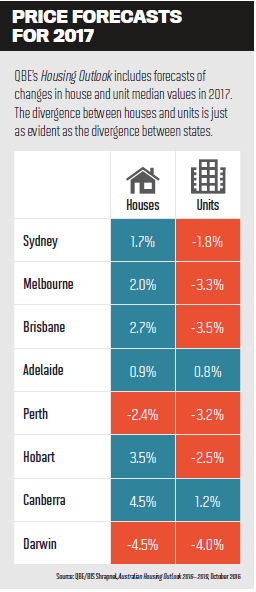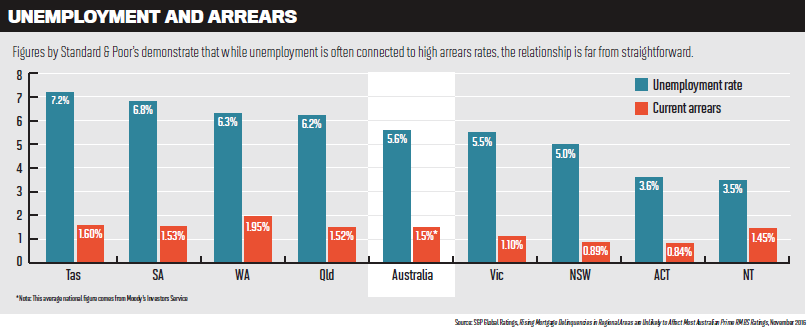States, regions and types of property are facing very different prospects in 2017 when it comes to housing.
.jpg)
The same argument was made by real estate mogul John McGrath, introducing his 2017 McGrath Report. “The question that people ask me most frequently is ‘What’s the market doing?’,” McGrath said. “To which of course there is no accurate answer other than to refine the question with the response: ‘Which market?’.”
 The RBA also observed that “housing markets had continued to diverge across the country” when it held cash rates in November. QBE’s Housing Outlook put this divergence into numbers: a predicted 2.0% increase in Melbourne house prices contrasts with a -2.4% fall in Perth and a 0.9% rise in Adelaide
The RBA also observed that “housing markets had continued to diverge across the country” when it held cash rates in November. QBE’s Housing Outlook put this divergence into numbers: a predicted 2.0% increase in Melbourne house prices contrasts with a -2.4% fall in Perth and a 0.9% rise in Adelaide Are brokers in for a divergence of their own? Falling prices mean falling commission; fewer buyers mean fewer borrowers. Brokers face “sobering” prospects in Queensland and Western Australia, the MFAA’s November Industry Intelligence Service (IIS) report warned, noting that WA “is not in equilibrium between the depth of its broker resources, and the available market opportunity”.
Yet what the data suggests is quite different to experience on the ground, as MPA found when we spoke to three brokers in WA, Queensland and South Australia.
Top 100 Broker Natalie Tinecheff has run Q Mortgage in Perth since 2004, and she’s certainly noticed the recent downturn. “The biggest change I see is in consumer confidence and their confidence in when to move or not move on potential investments or owneroccupier purchasing,” she said. Volumes are “a lot less than they were”, but there are still just as many first home buyers, as well as refinancers. Unemployed clients soon find work again, Tinecheff explained. The very few arrears that do occur aren’t due to the economy. “When you get into it there’s personal circumstances around it, more than employment,” she said.
In fact, Tinecheff hasn’t changed her approach at all, and volumes are beginning to rise again. Many of Perth’s difficulties lie in the imagination, she believes. “Perth is always used as the ‘bottom of the barrel’ reference point in the rest of Australia, and people in Perth are listening to that. They’re starting to realise now the market isn’t going to go back any further.”
Town and country
You need to drill down into the state markets to get a clear view of 2017’s prospects. In November, international ratings agency Standard & Poor’s found that mortgage arrears in rural areas were growing at nine times the rate of arrears in metropolitan areas.
“Despite historically low interest rates we expect the performance of arrears in capital cities and regional areas to continue to diverge,” S&P stated, warning that “regional unemployment persists in many parts of the country, with no signs of abating”.
One regional area investigated by S&P was the Sunshine Coast. Local Top 100 Broker Colin Mason, who operates his brokerage, SMS Finance, from Maroochydore, told MPA he was not concerned.
“Business growth for us has been phenomenal,” Mason said. “We’ve seen more activity this year than in many other years, and a lot of that stems from the development that’s been happening on the coast.” Recent developments in infrastructure, including a new hospital, have made the region more attractive as a lifestyle choice, he said. “I think the Sunshine Coast is poised for a lot of growth over the next few years.”
Mason hasn’t seen any mortgage delinquencies this year, and part of the reason for that is the Sunshine Coast’s local economy: unemployment is below the national average, at 4.9%. The same cannot be said for the rest of Queensland. In Wide Bay, a 2.07% arrears rate correlates with an 8.9% unemployment rate; in Townsville the figures are 2.13% and 9.7% respectively. These statistics come from S&P, which found that housing markets in areas disproportionally reliant on mining and manufacturing fared worse than those areas with more diversified economies.
Over-reliance is also a problem for some capital cities. Mining-reliant areas in Queensland are suffering, but Brisbane’s housing market won’t be much affected, CoreLogic’s head of research, Cameron Kusher, told MPA. However, in Perth, the mining industry’s problems have had a direct influence, Kusher said. “Certainly in WA these falls have more of an impact because the economy is so reliant on the resources sector.”
Nevertheless, he explained, “the mining towns are such a small proportion of the overall housing market it doesn’t have much of an impact”. Moreover, in 2017 the negative impacts of mining’s decline on house prices could lessen, Kusher suggested. “I don’t think we’ll see rapid declines; we’ve already seen values in Darwin and Perth fall by about 10%. I think we’ll see a bit of a decline over the next 12 months, but it’s not going to gather pace: if anything it’ll slow a little bit.”
.PNG)
“I think we’ll see a bit of a decline over the next 12 months but it’s not going to gather pace: if anything it’ll slow a little bit” - Cameron Kusher, CoreLogic
Houses and units
Kusher identifies a third divergence we’ll see in 2017: a price divergence between houses and units. “If we’re talking about an oversupply of housing we’re probably talking about the unit market,” he explained. “We are concerned about the amount of unit stock being built in certain parts of certain cities, and that could lead to a downturn in prices in that market probably late that year, maybe into 2018.” Those areas are located in inner Brisbane, outer Sydney and inner Melbourne; QBE’s Housing Outlook predicts unit prices will drop in all three of these cities over 2017, by -3.5%, -1.8% and -3.3% respectively.
Homeowners in these cities shouldn’t be concerned, Kusher said. “We think if anything that divergence will grow and I don’t necessarily see a downturn in the unit market having much of an effect on the detached housing market.” Foreign investors have been one of the major sectors buying off-the-plan apartments, yet the McGrath report predicted that “reduced Chinese demand and settlement defaults will hit the apartment sector most”. And even if these apartments became cheaper, Kusher said, local owner-occupiers were unlikely to be tempted as these apartments were often too small for them.
MPA asked Kusher which areas were most and least likely to experience price falls in 2017, and how houses and units would be affected. For houses, Sydney and Melbourne remained a good bet, Kusher said. “Population growth is still very strong, and interest rates are very low, and people have showed a preparedness to borrow in both of these markets.” Yet Melbourne, along with Brisbane, was most vulnerable to a fall in unit prices (Perth and Darwin were the most vulnerable to house price changes). In fact the best place for units, in Kusher’s opinion, was an unlikely choice: Hobart. “You haven’t seen much unit construction, you’re seeing investor demand pick up, we’re seeing demand from overseas travellers to Tasmania pick up a lot.”
“Reduced Chinese demand and settlement defaults will hit the apartment sector most” John McGrath, McGrath Estate Agents
Your brokerage
There is a fourth and final divergence we’ll see in 2017, between the brokers who succeed and those who struggle. This may have little to do with the local economy: the MFAA’s IIS report observed that despite WA’s economic challenges, established brokers there had an important advantage, namely “the highest gross trail remuneration generated per broker, a function of materially the largest average loan book per broker”.
Having a large trail book accumulated over 12 years and just one assistant has certainly helped Q Mortgage’s Tinecheff.
“Perseverance is the only choice you have,” she advises other brokers. “If you can persevere through this bad time the good times are coming and they’re amazing when they’re here. Your trail book during the boom is what gets you through the bust.”
Even for those brokers without large trail books, there’s still room for growth. Weng Wong started his brokerage, Entourage Finance, in 2014 and has achieved strong year-on-year growth as well as being nominated for awards despite prices in Adelaide being almost flat.
“At the end of the day, for any broker the amount of money you make and the business you write comes down to yourself and how you go about getting business,” he told MPA. “Low interest rates? They’re a great opportunity to be targeting refinancing, and you don’t need to worry that much about the people who aren’t buying.”
If nothing else, a quiet market frees you up to do other things, as Tinecheff has found: “I’ve chosen to take advantage of Perth being quieter at the moment to deal with my own life. I’m renovating and buying and doing all those things I never had time for, so I’m really enjoying the break.”





